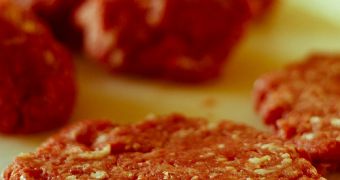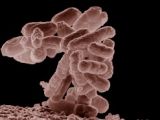Hamburger disease is a debilitating form of food poisoning, that might soon be forgotten thanks to new findings from a collaboration between international researchers, led by the French National Institute for Agronomic Research (INRA), involving the Université de Montréal.
This is the first research that shows that the contaminating E.coli bacterium can and does survive in the very bacteria-competitive environment of a cow's intestine, by feeding on specific food sources, and it could lead to non-medicinal ways of eradicating this pathogen.
The hamburger disease is actually called the haemolytic uremic syndrome, and it occurs in people who have been infected with the E. coli O157:H7.
It normally affects children between 1-10 years old, but it can also affect adults, the figures being between 2 and 4 individuals out of 100,000.
The disease can occur in any place in the world, and it can destroy the cells that cause clotting of the blood and red cells.
It can also lead to kidney failure because of the damage of the small blood vessels and tubules in the kidneys.
Within the intestine, there are all sorts of bacteria, most of which contribute to the proper functioning of the bowels, but there are also harmful bacteria, that struggle constantly for carbon, nitrogen and other sources of energy.
This very complex environment makes that bacteria that win the battle survive and get to multiply, while others disappear completely.
Josée Harel, co-author of the study and director of the Groupe de Recherche sur les Maladies Infectieuses du Porc at the Université de Montréal's Faculty of Veterinary Medicine said that they have “studied E.coli O157:H7, which is the most prevalent species of bacteria associated with larger outbreaks.
“These outbreaks have been associated with direct contact with the farm environment and with the consumption of meat, raw milk and dairy products.
“Reduction or eradication of O157:H7 in cows will lead to a substantial decrease in food contamination and consequential human infections.”
Along with her collaborators' from France's Institut National de la Recherche Agronomique and Lallemand Animal Nutrition, Harel's first step was to prove that O157:H7 does in fact thrive in the bovine intestine.
Once this was achieved, the researchers wanted to understand why do these bacteria enjoy this environment so much, and the reason soon became obvious: the O157:H7 is not your average bacteria, as it can forage nitrogen from ethanolamine – a chemical present in the cow's intestine.
And because there are no other bacteria that can process ethanolamine, the O157:H7 never risks starvation.
Harel said that “the ability of O157:H7 to use ethanolamine as a source of nitrogen gives it the nutritional and competitive advantage to survive.”
The researchers then wanted to know what gave the O157:H7 the ability to process ethanolamine and turn it into a nitrogen source, and they discovered that it actually has specific genes that do the job.
“We now know that this bacteria has evolved a genetic program that allows it to process ethanolamine and therefore outcompete its neighbors and survive and multiply in the intestine,” Harel said.
“This new-found knowledge will help us select appropriate feed or probiotics in an attempt to eliminate the food source of this contaminating bug.
“This in turn, should limit the spread of this bug into the food chain.”
This research was funded by an EU project (ProjectSafeBeef) within the 6th Framework Program, it was published in this month's Environmental Microbiology, and featured in Nature Reviews Microbiology.

 14 DAY TRIAL //
14 DAY TRIAL // 
